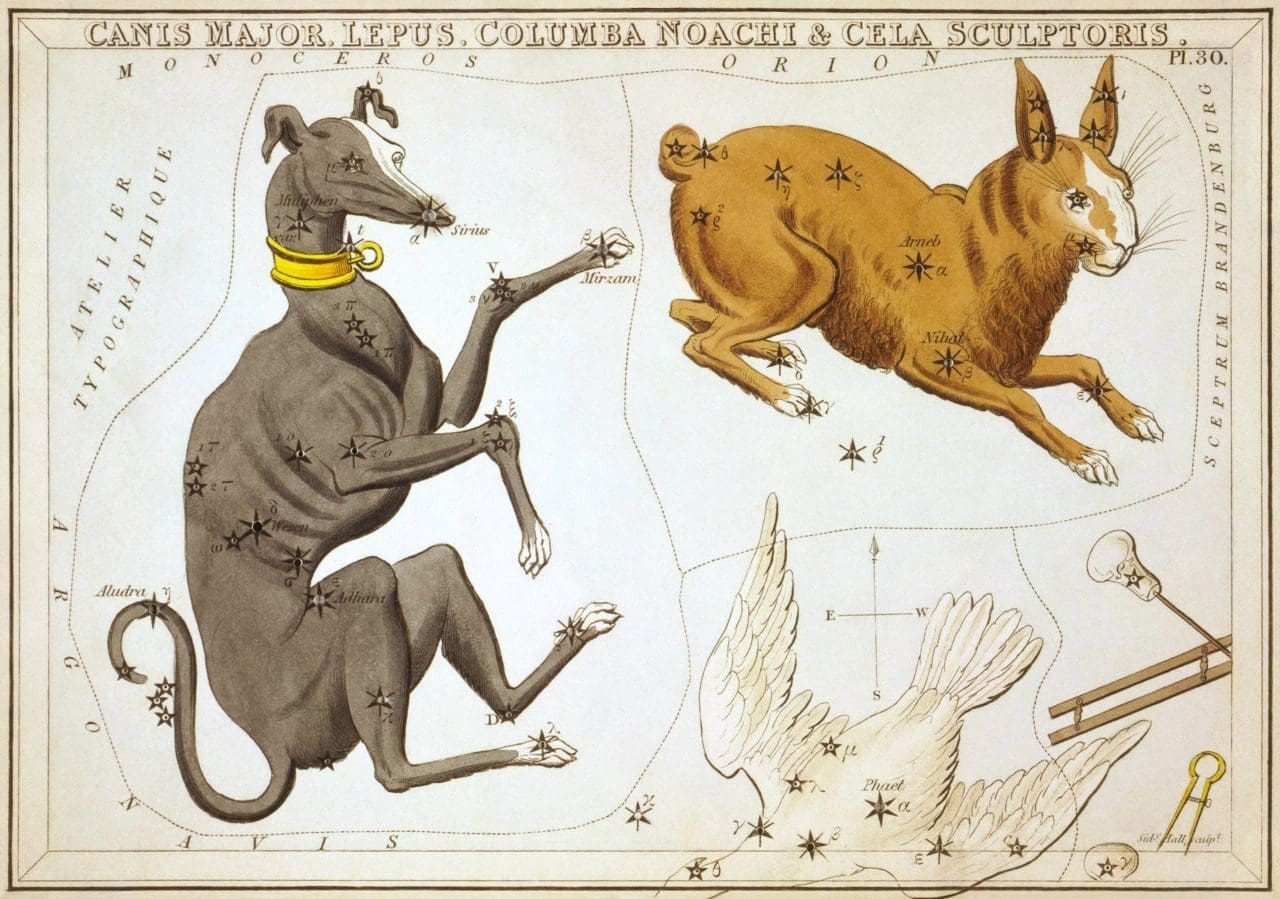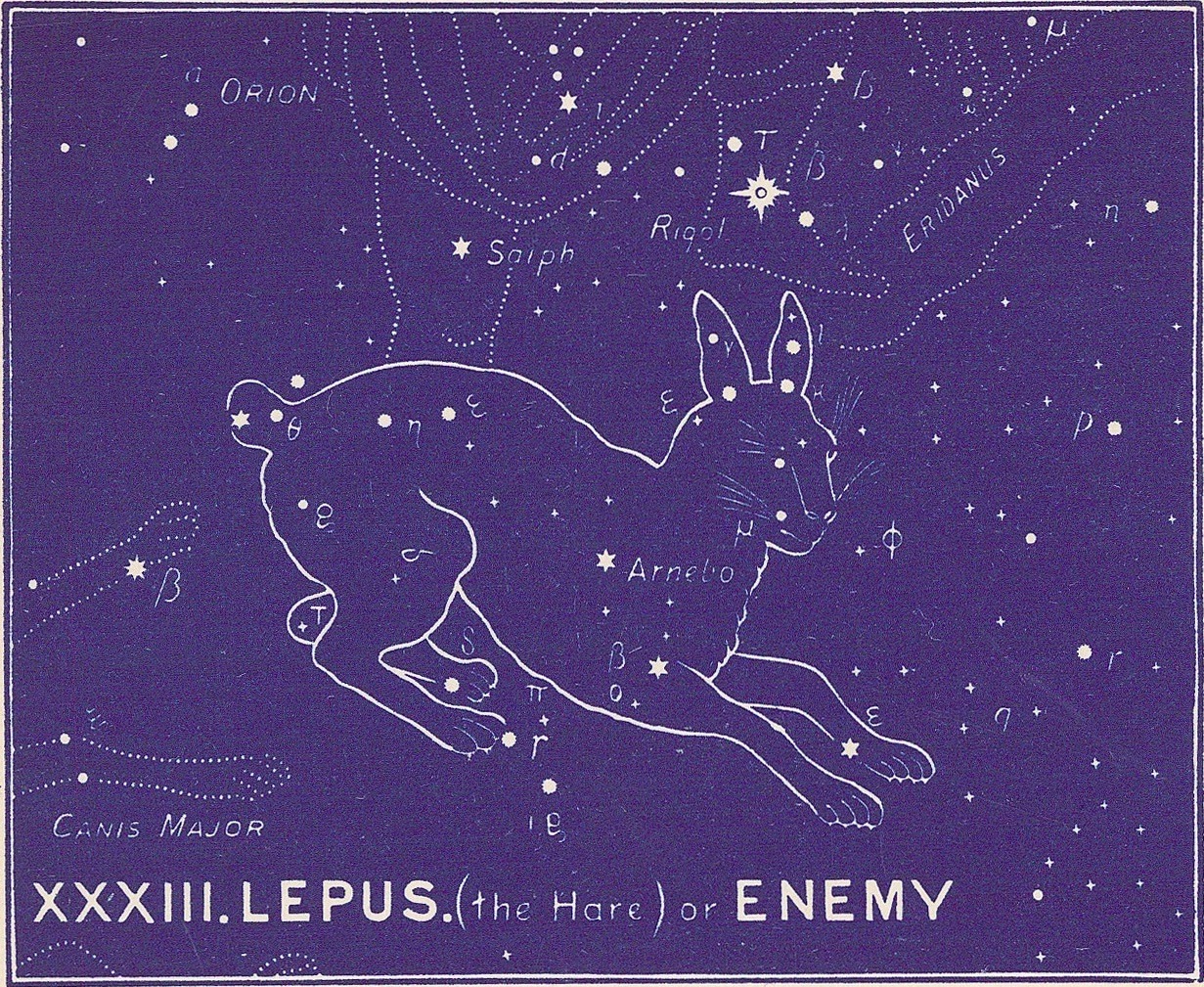FIXED STARS: Major Stars | 1000+ Stars | Constellations | About
Constellation Lepus the Hare is a southern constellation bordering Orion, Eridanus, Caelum, Columba, Canis Major, Monoceros and the obsolete constellation Sceptrum Brandenburgicum.Lepus is one of the 48 constellations listed by Ptolemy in the 2nd century and remains one of the 88 modern constellations. It spans 20 degrees of the zodiac in the Sign of Gemini.
Abbreviation: Lep
Genitive: Leporis
Lepus Constellation Stars
| 2000 | 2050 | Star | Name | Sp. Class | Mag. | Orb |
|---|---|---|---|---|---|---|
| 12♊04 | 12♊46 | ε Lep | Sasin | K4 | 3.19 | 1°50′ |
| 15♊24 | 16♊06 | μ Lep | Neshmet | B9 | 3.29 | 1°50′ |
| 17♊47 | 18♊29 | λ Lep | B0 | 4.29 | 1°20′ | |
| 19♊41 | 20♊23 | β Lep | Nihal | G5 | 2.81 | 2°00′ |
| 21♊23 | 22♊05 | α Lep | Arneb | F0 | 2.58 | 2°00′ |
| 24♊51 | 25♊33 | γ Lep | Kursi al Jabbar | F7 | 3.59 | 1°40′ |
| 26♊00 | 26♊42 | ζ Lep | A2 | 3.55 | 1°40′ | |
| 27♊11 | 27♊53 | δ Lep | Arsh al Jauzah | G8 | 3.76 | 1°30′ |
| 28♊54 | 29♊37 | η Lep | F1 | 3.71 | 1°30′ | |
| 01♋54 | 02♋36 | θ Lep | A0 | 4.67 | 1°00′ |
Lepus Astrology
Manilius
To those born under this constellation nature all but gives wings and flight through the air – such will be the vigor of limbs which reflect the swiftness of the winds. One man will come off winner in the footrace before even receiving the signal to start; another by his quick movement can evade the hard boxing-glove and now lightly avoid, now land a blow; another can with a deft kick keep in the air a flying ball, exchanging hands for feet and employing in play the body’s support, and execute with nimble arms a volley of rapid strokes; yet another can shower his limbs with a host of balls and create hands to spring up all over his body with the result that, without dropping any of the number, he plays against himself and causes the balls to fly about his person as though in answer to his command. Such a man devotes wakeful nights to his concerns, for his energy banishes sleepiness whilst he spends happy work-free hours in games of divers kinds. [1]
Robson
Legend. A young man of the Isle of Leros greatly desired a hare and brought some over, for none were to be found on the island. The other inhabitants also wished to keep hares, but eventually the animals multiplied to such an extent that there was not enough food for them and they devoured the corn in the fields, whereupon the inhabitants joined together and destroyed them all.
Influence. According to Ptolemy, Lepus is like Saturn and Mercury. It gives a quick wit, timidity, circumspection, fecundity and defiance.
Magical. Guards against deceit and madness. [2]
Allen
Lepus, the Hare… is located just below Orion and westward from his Hound.
It was Λαγώς among the Greeks.
Among the Romans it was simply Lepus.
The Arabians adopted the classical title in their Al Arnab… but the early Arabs designated the principal stars, α, β, γ, and δ — as Al Kursiyy al Jabbār and Al ʽArsh al Jauzah, the Chair of the Giant and the Throne of the Jauzah.
Al Sufi also cited the occasional Al Nihāl, the Thirst-slaking Camels, for the four bright stars, in reference to the near-by celestial river, the Milky Way.
It is in the space occupied by Lepus, or perhaps by Monoceros, that Hommel locates the Euphratean Udkagaba, the Smiting Sun Face, although Brown assigns this to Sagittarius, “the original Sagittary being the sun.”
Hewitt says that in earliest Egyptian astronomy Lepus was the Boat of Osiris, the great god of that country, identified with Orion. The Chinese knew it as Tsih, a Shed.
Gould catalogues in Lepus 103 stars down to the 7th magnitude.
Brown writes of the often discussed comparative location of Lepus and Orion:
The problem which perplexed the ancients, why the Mighty-hunter and his Dog should pursue the most timid of creatures, is solved when we recognize that Orion was originally a solar type, and that the Hare is almost universally a lunar type;
and mentions the very singular connection between this creature and the moon shown on Euphratean cylinders, Syrian agate seals, Chinese coins, the Moon-cakes of Central Asia, and in the legends of widely separated nations and savage tribes. Astronomical folk-lore has many allusions to this interesting association of animal with satellite, and indirectly with our constellation. The common idea that it is because all are nocturnal does not seem satisfactory; and there are others still less so, some being mentioned by Beaumont and Fletcher in the Faithful Shepherd.
The Hindus called the moon Çaçin, or Ṣaṣānka, Marked with the Hare, from the story told of Sakya muni (Buddha)… Other Sanskrit and Cingalese tales mention the palace of the king of the hares on the face of the moon; the Aztecs saw there the rabbit thrown by one of their gods; and the Japanese, the Jeweled Hare pounding omochi, their rice dough, in a mortar. Even the Khoikhoin, the Hottentots of South Africa, and the Bantus associated the hare and moon in their worship, and connected them in story, asserting that the hare, ill treated by the moon, scratched her face and we still see the scratches. Eskimos think the moon a girl fleeing from her brother, the sun, because he had disfigured her face by ashes thrown at her; but in Greenland the sex of these luminaries is interchanged, and the moon pursues his sister, the sun, who daubs her sooty hands over his face. The Khasias of the Himalayas say that every month the moon falls in love with his mother-in‑law, who very properly repulses his affection by throwing ashes at him.
The Incas knew them as a beautiful maiden who fell in love with the moon and joined herself forever to him; the New Zealanders, as a woman pulling gnatuh; the Hervey Islanders, as the lovely Ina, an earthly maiden carried away to be our satellite’s wife, and still visible with her pile of taro leaves and tongs of a split cocoanut branch; and the Samoans, as a woman with her child and the mallet with which she is pounding out sheets of the native paper cloth. [3]
Bullinger
In the Persian planisphere the first constellation was pictured by a serpent. In the Denderah (Egyptian) Zodiac it is an unclean bird standing on the serpent, which is under the feet of Orion. Its name there is given as Bashti-beki. Bashti means confounded, and Beki means failing. It is a small constellation of 19 stars (all small), three of which are of the 3rd magnitude, seven of the 4th, etc.
The brightest, α (in the body), has a Hebrew name, Arnebo, which means the enemy of Him that cometh. The Arabic, Arnebeth, means the same. Other stars are Nibal, the mad; Rakis, the bound (Arabic, with a chain); Sugia, the deceiver. [1]
References
- Astronomica, Manilius, 1st century AD, book 5, p.313.
- Fixed Stars and Constellations in Astrology, Vivian E. Robson, 1923, p.49, 231.
- Star Names: Their Lore and Meaning, Richard H. Allen, 1889, p.264-269.
- The Witness of the Stars, E. W. Bullinger, 1893, Lepus (the Hare).


